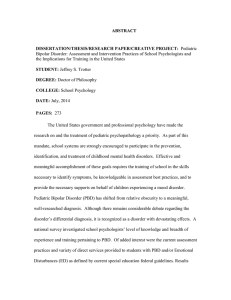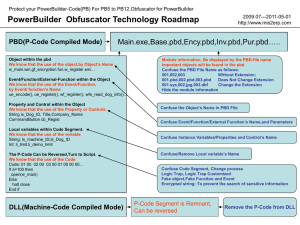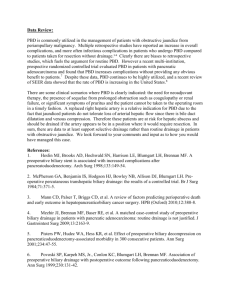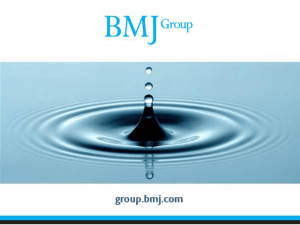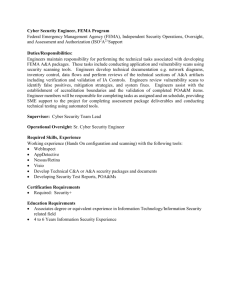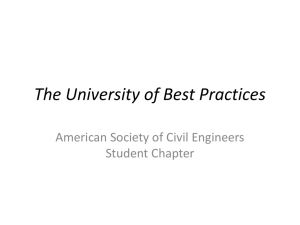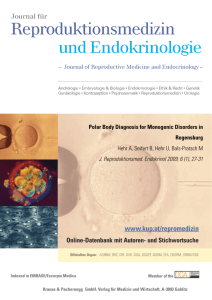Minutes
advertisement
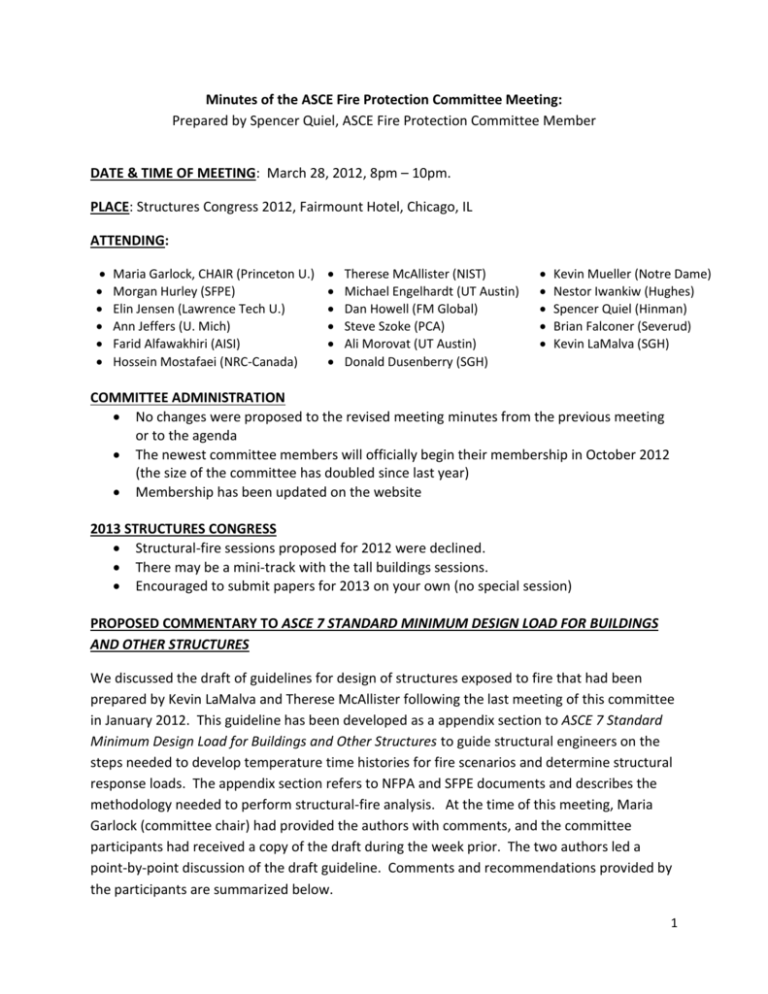
Minutes of the ASCE Fire Protection Committee Meeting: Prepared by Spencer Quiel, ASCE Fire Protection Committee Member DATE & TIME OF MEETING: March 28, 2012, 8pm – 10pm. PLACE: Structures Congress 2012, Fairmount Hotel, Chicago, IL ATTENDING: Maria Garlock, CHAIR (Princeton U.) Morgan Hurley (SFPE) Elin Jensen (Lawrence Tech U.) Ann Jeffers (U. Mich) Farid Alfawakhiri (AISI) Hossein Mostafaei (NRC-Canada) Therese McAllister (NIST) Michael Engelhardt (UT Austin) Dan Howell (FM Global) Steve Szoke (PCA) Ali Morovat (UT Austin) Donald Dusenberry (SGH) Kevin Mueller (Notre Dame) Nestor Iwankiw (Hughes) Spencer Quiel (Hinman) Brian Falconer (Severud) Kevin LaMalva (SGH) COMMITTEE ADMINISTRATION No changes were proposed to the revised meeting minutes from the previous meeting or to the agenda The newest committee members will officially begin their membership in October 2012 (the size of the committee has doubled since last year) Membership has been updated on the website 2013 STRUCTURES CONGRESS Structural-fire sessions proposed for 2012 were declined. There may be a mini-track with the tall buildings sessions. Encouraged to submit papers for 2013 on your own (no special session) PROPOSED COMMENTARY TO ASCE 7 STANDARD MINIMUM DESIGN LOAD FOR BUILDINGS AND OTHER STRUCTURES We discussed the draft of guidelines for design of structures exposed to fire that had been prepared by Kevin LaMalva and Therese McAllister following the last meeting of this committee in January 2012. This guideline has been developed as a appendix section to ASCE 7 Standard Minimum Design Load for Buildings and Other Structures to guide structural engineers on the steps needed to develop temperature time histories for fire scenarios and determine structural response loads. The appendix section refers to NFPA and SFPE documents and describes the methodology needed to perform structural-fire analysis. At the time of this meeting, Maria Garlock (committee chair) had provided the authors with comments, and the committee participants had received a copy of the draft during the week prior. The two authors led a point-by-point discussion of the draft guideline. Comments and recommendations provided by the participants are summarized below. 1 GENERAL DISCUSSION OF THE DRAFT The draft is currently NOT on the committee website o Will be put into ASCE’s e-room (online location for draft documents – contact Jennifer Goupil) NFPA and SFPE documents can be used to calculate fire loads. Heat transfer methodology guidance is under development. This document is intended for structural engineers working in conjunction with fire protection engineers o Needs to provide background and lead to analysis of the structural response to fire Should non-building structures be considered? o May have a higher probability of fire exposure o Bridges are not included o Chemical facilities may be included? Historical examples of successful use of PBD would provide justification and context for PBD. The document should establish why the engineer would want to use PDB. Case studies of building performance in fire could be provided: o One Meridian Plaza, Philadelphia, PA o First Interstate Building, Los Angeles, CA o Overland Park, KS partial collapse o World Trade Center 1, 2, 5, 7 Concern: would a change of occupancy in a building be a problem if its fire protection was calculated using PBD for a fuel load specific to the previous occupancy? o Fire protection engineers routinely face this issue; usually requires specific analyses o If the fuel load is increased, new calculations would need to be performed. Literature suggests that design fire calculations in the NFPA and SFPE documents may not be as sensitive to the input variables as suspected by some of the other meeting participants. This is because building fires are usually ventilation controlled. Load ratios for gravity loads in combination with fire effects that are dependent on occupancy should be considered. If this document is simple to use and well organized, engineers will be more likely to use it and building departments will be more likely to understand it Should the document recommend higher levels of design for egress routes or refuge areas? For example, building codes treat stairway towers as safe exits (i.e., being in a stairway tower is equivalent to being outside the building); the stairway tower should not be susceptible to collapse. SECTION E3 (DESIGN OBJECTIVES) A lot of burden to determine the appropriate level of safety/reliability is put on the Authority Having Jurisdiction (AHJ). o Need quantifiers such as NFPA 5000 to obtain building importance factors 2 o Similar to using IBC AHJ language should be removed because this is an appendix and is not mandatory Design objectives should include reaching burnout without collapse. Mission continuity is typically not addressed in building codes and is more critical to owners and insurers. SECTION E4 (DESIGN APPROACHES) T. McAllister and Craig Beyler (Hughes) are discussing probabilistic approaches to developing fire loads. “Fire severity” was replaced with “fire load effects” in the draft o Terminology is more familiar to structural engineers o Fire load effects impact both the structural demand and capacity Performance time history needs to be a central component of PBD analysis and design o When a structural element is hottest may not be the most critical time o Distinction between “fire duration” and “burnout” needs to be made o The concept of Fire Resistance > Fire Load Effects may not make sense for temperature-time domain Should we consider re-organizing the draft into two general sections: prescriptive vs. PB methods? o Three domains: Time, Temperature, and Strength o All three domains could be either prescriptive or PB o Should a graded approach from prescriptive to partial prescriptive to full PB be considered? It may be difficult to get away from the time domain coefficients (i.e. how an hourly rating will perform) to get toward PBD o The draft does not directly address hourly ratings o A peer review of designs using hourly ratings using PBD could be performed Will the load combination be a function of the fire duration? Distinction between prescriptive and PBD has become less clear o Historically, standard tests were considered to be PB – now they are considered prescriptive o Should new terminology (such as “qualification testing”) be considered? Eq. 2.5-1: should the live load factor account for occupancy (such as storage or semipermanent loads)? o Other codes worldwide use 0.9 or 1.0 for live load factors. o Engineer will need to use judgment regarding the appropriate loading (i.e. a full arena for a terrorist threat would consider a higher live load) SECTION E5 (THERMAL RESPONSE) Fuel load NFPA 557; Fire Exposure SFPE Handbook Should spreading, multi-floor, or traveling fire be considered in this document? o After the WTC investigation, there is a basis for considering traveling fires. Should exterior fires be considered? 3 Should a “special considerations” section be added that deals specifically with fire scenarios beyond the single compartment design fire for buildings? Should post-earthquake fires be considered? o EQ damage may be non-structural in addition to structural o Damage to fire protection systems will make the building more susceptible to fire o Probability of a fire starting is greater following an EQ Fire protection engineer would be communicating with the structural engineer to develop the thermal response o Fire protection engineer would perform the heat transfer analysis and provide the results to the structural engineer Non-uniform heating should be considered o Concrete and steel will have different heating profiles and should be differentiated. SECTION E6 (STRUCTURAL RESPONSE) Consensus is that this document should refer to other documents for material properties, fire curve inputs, etc. rather than listing a large amount of information o D. Dusenberry: if this section will eventually be in the mandatory portion of ASCE 7, then references can ONLY be made to consensus documents – otherwise the information would have to be included in this document o AISC’s new fire appendix could be referenced for steel; ACI does not yet provide material properties under fire conditions Post-tensioned/prestressed concrete systems are not addressed – should they be included? o ACI 216.1 have information that could be referenced or added Design examples for several construction types would be helpful o ISO is currently developing some examples? NEXT STEP FORWARD The committee will continue to focus on the development the draft PBD commentary. Comments provided during and after this meeting will be addressed as the document progresses toward a second draft. A key area to be addressed going forward is the distinction between prescriptive and PBD approaches and the decision of which approach is appropriate for a given design or analysis. Section E6 (structural response) is currently in preliminary draft form and will be further developed. The committee is planning to meet in Summer 2012 (schedule pending) to discuss new developments in the draft commentary and provide additional comments. A draft of the Appendix must be submitted to ASCE 7 Main Committee by October 2012. 4
